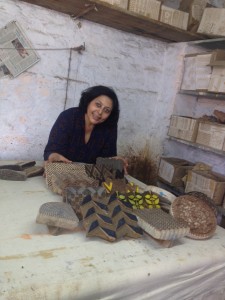Artist Statement –
Inspiration-
The Salt March, also known as the Salt Satyagraha, began with the Dandi March on March 12, 1930, and was an important part of the Indian independence movement. It was a direct action campaign of tax resistance and nonviolent protest against the British salt monopoly in colonial India, and triggered the wider Civil Disobedience Movement. This was the most significant, organized challenge to the British authority since the Non-cooperation movement of 1920–22, and was directly followed by the Purna Swaraj declaration of independence by the Indian National Congress on January 26, 1930.

My work as an artist is centered on historical and iconographic elements within a particular cultural context of Indian history. I explore and construct the hermeneutics of period histories along with socio-economic and political inquiry of representation and identity. While my works draw upon India’s colonial past, they also engage with contemporary economic interchanges by means of collaborations with artisans and non-profit organisations.
My present body of work ’Salt: The Great March 2013’, explores social activism propounded by the Gandhian philosophy of sarvodya and swadhrma. The salt becomes symbolic of Gandhi’s renunciatory spirit, of cultural and moral values as instruments to create the better societies. I am investigating that art through sarvodya concept when intervened with social issues that reaching threatening proportions in public domain and are destabilising the social fabric in our lives – Can swadharma become a movement for uplifting of societal values? What are the implications of involving art with an audience where corrupted and corroded human values crumble the foundational strength of the societies, communal living and beliefs ?
I began my journey for the art project “Salt The Great March” by reading Mark Kurlansky’s book Salt : A World History (Penguin Books, 2003) and then proceeded with a deeper inquiry into Gandhi’s historical Salt March. At the same time, my translational research in azrakh printing works on khadi and quilting on the same, became an extended exploration.  I have been working with the 9/10th generation of azrakh artisans in Bhuj since 2009. My aesthetic decisions regarding this particular textile printing and dyeing techniques are formed by a sense of responsibility as an artist to preserve these elaborate textile processes by converting the printing technique itself into an artwork. I hope to contribute towards the preservation of the azrakh technique through my artwork and through exhibitions in galleries and museums. The wooden blocks used for my contemporary printed works date back to about 200 years in design history and the dyes used are natural and eco-friendly. The design styles referenced in my work are kankharak, Rialgad, gurda kaleji, bodyrial, Zimardi, Beedi boota, Asopalav, Nipuri, champakali, Pancho,Keribel, Mijidbel. To enhance this textile art, I have further used traditional needle craft techniques with Sujni and Nakshi Kanthas (running stitch needle work) stitches belonging to eastern India, which date back to the18th century and used primarily by Hindu women.
I have been working with the 9/10th generation of azrakh artisans in Bhuj since 2009. My aesthetic decisions regarding this particular textile printing and dyeing techniques are formed by a sense of responsibility as an artist to preserve these elaborate textile processes by converting the printing technique itself into an artwork. I hope to contribute towards the preservation of the azrakh technique through my artwork and through exhibitions in galleries and museums. The wooden blocks used for my contemporary printed works date back to about 200 years in design history and the dyes used are natural and eco-friendly. The design styles referenced in my work are kankharak, Rialgad, gurda kaleji, bodyrial, Zimardi, Beedi boota, Asopalav, Nipuri, champakali, Pancho,Keribel, Mijidbel. To enhance this textile art, I have further used traditional needle craft techniques with Sujni and Nakshi Kanthas (running stitch needle work) stitches belonging to eastern India, which date back to the18th century and used primarily by Hindu women.
The two site specific installations, ‘Integrating Khadi 2013’ and ‘Re-Building my nation 2013’ represent and incorporate the ‘thread of Swaraj’ and the ‘Khadi spirit’. I have used 40 meters of khadi fabric with block printed Sanskrit calligraphy depicting a sense of nationalism and patriotism in 2013. ‘Re-building my nation 2013’ is constructed with chennile pipe cleaners, fabric, threads as a metaphoric representation of communities living harmoniously. ‘Salt: The Great March’ series is an extension of my previous project ‘Indigo Narratives’ (2009-13) which narrated the history of indigo as a plant colour and dye in reference to its sustained presence in the post-colonial identity of Indian history.
My new works on ‘Salt’, feature a large khadi fabric site specific installation, two sculptural installation with khadi yarns, chennile pipe cleaners and wires, twenty-five contemporary artworks on khadi as quilt samplers with traditional Azrak dyeing/ printing technique, and multi-media spoken poetry.
View images : ‘Salt March series’ in making in Ismail Mohmd khatri’s studio at Ajrakpur Bhuj, Gujarat , India
Acknowledgements:
Special thanks to all below in the making of SALT MARCH series
The Museum Dakshin Chitra , Chennai,IIC India International Centre, New Delhi, IGNCA Indira Gandhi National Centre for the Arts, New Delhi, Johny ML-Critic, Writer & curator : Essay, New Delhi, Photography credits : Inder gopal, New Delhi, Documentary film : Sayyed Jawed Asghar, New Delhi Audio recording Studio : Pindrop, Haus khas, New Delhi, Sejal Handicrafts :Sanskrit calligraphy block printing on khadi fabric Baroda, Gujarat, Studio:Mohamed Ismail khatri, Master craftsman, Bhuj ,Gujarat, Junaid Ismail khatri, Master craftsman Bhuj, Gujarat, Sakobhai, Rafiq Pandhi, Rahim khatri, Razak -Azrakh Artisans, Bhuj, Gujarat, Rakesh khandelwal & Co :Constructional finishes and needle work, New Delhi, Gallery installations :Trident exhibitions, Noida U.P, Dress forms : Figurette INC kalkaji, New Delhi, Fawd khatri :Mens wear formal Ajrak jackets, Grahics credits : Prashant Seal
